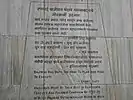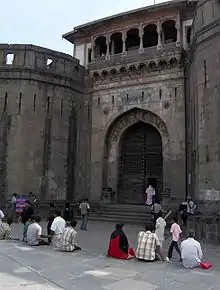Baji Rao I
Baji Rao I (18 August 1700 – 28 April 1740), born as Visaji,[1] also known as Bajirao Ballal,[2] was the 7th Peshwa (Prime Minister) of the Maratha empire. In his 20-year military career, he never lost a battle and is widely considered as one of the best Indian cavalry generals.[3][4] His relationship with his half-Muslim wife Mastani, a subject of controversy,[5][1] has been adapted in Indian novels and cinema.[6][7][8]
Baji Rao I | |
|---|---|
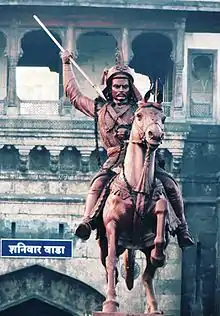 Equestrian statue of Baji Rao I outside Shaniwarwada in Pune | |
| In office 17 April 1720 – 28 April 1740 | |
| Monarch | Shahu I |
| Preceded by | Balaji Vishwanath |
| Succeeded by | Balaji Bajirao |
| Personal details | |
| Born | 18 August 1700 Dubere, Sinnar, Maratha Empire (present-day Nashik district, Maharashtra, India) |
| Died | 28 April 1740 (aged 39) Raverkhedi, Maratha Empire (present-day Khargone district, Madhya Pradesh, India) |
| Spouse(s) | |
| Relations |
|
| Children |
|
| Mother | Radhabai Barve |
| Father | Balaji Vishwanath |
Early life
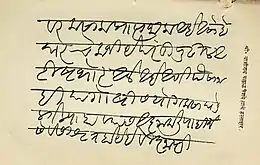
Baji Rao was born into the Bhat family in Sinnar. His father, Balaji Vishwanath, was a Peshwa of Shahu and his mother was Radhabai Barve.[9] Baji Rao had a younger brother, Chimaji Appa, and two younger sisters, Anubai and Bhiubai. Anubai was married to Venkatrao Ghorpade of Ichalkaranji and Bhiubai was married to Abaji Naik Joshi of Baramati.[10]
Baji Rao spent his childhood in his father's newly acquired fiefdom of Saswad. He and Chimaji were very close.[10] Baji Rao was inspired by the lives of Shivaji, Sambhaji, Ramchandra Pant Amatya and Santaji Ghorpade.[11]
He was trained as a diplomat and a warrior under his father. Being born in a Brahmin family, his education included reading, writing and learning Sanskrit; however, he did not remain confined to his books. Baji Rao displayed a passion for the military at an early age and often accompanied his father on military campaigns.[12][13] He was with his father when his father was imprisoned by Damaji Thorat before being released for a ransom.[1] Baji Rao had been on the expedition to Delhi in 1719 with his father and was convinced that the Mughal Empire was disintegrating and unable to resist northward Maratha expansion.[14] When Balaji Vishwanath died in 1720, Shahu appointed the 20-year-old Baji Rao as Peshwa despite opposition from other chieftains.[15] He is said to have preached the ideal of a Hindu Pad Padshahi (Hindu empire).[16]
Appointment as Peshwa
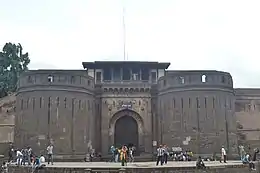
Baji Rao was appointed Peshwa, succeeding his father, by Shahu on 17 April 1720. By the time of his appointment, the Mughal emperor Muhammad Shah had upheld Maratha claims to the territories held by Shivaji at his death. A treaty gave the Marathas the right to collect taxes (chauth) in the Deccan's six provinces.[17] Baji Rao convinced Shahu that the Maratha Empire had to go on the offensive against its enemies to defend itself.[18] He believed that the Mughal Empire was in decline, and wanted to take advantage of the situation with aggressive expansion into North India. Baji Rao compared the Mughals' declining fortune to a tree which, if attacked at its roots, would collapse. He is reported to have said:
Let us strike at the trunk of the withering tree and the branches will fall off themselves. Listen but to my counsel and I shall plant the Maratha flag on the walls of Attock.[19]
As a new Peshwa, however, he faced several challenges.[1] His appointment at a young age had evoked jealousy from senior officials such as Naro Ram Mantri, Anant Ram Sumant, Shripatrao Pant Pratinidhi, Khanderao Dabhade and Kanhoji Bhosle. Baji Rao promoted young men like himself, such as Malhar Rao Holkar, Ranoji Shinde, the Pawar brothers, Pilaji Jadhav and Fateh Singh Bhosle, as commanders; these men did not belong to families who were hereditary Deshmukhs in the Deccan sultanates.[20][21]
The Mughal viceroy of the Deccan, Nizam-ul-Mulk Asaf Jah I, had created a de facto autonomous kingdom in the region. He challenged Shahu's right to collect taxes[22] on the pretext that he did not know whether Shahu or his cousin, Sambhaji II of Kolhapur, was the rightful heir to the Maratha throne.[1] The Marathas needed to assert their rights over the nobles of newly acquired territories in Malwa and Gujarat.[1] Several nominally-Maratha areas were not actually under the Peshwa's control; for example, the Siddis controlled the Janjira fort.[1]
Military conquests
The Nizam
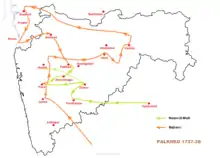
On 4 January 1721, Baji Rao met Nizam-ul-Mulk Asaf Jah I at Chikhalthana to resolve their disputes. However, the Nizam refused to recognize the Maratha right to collect taxes from the Deccan provinces.[1] He was made vizier of the Mughal Empire in 1721 by emperor Muhammad Shah, alarmed at his increasing power, transferred him from the Deccan to Awadh in 1723. The Nizam rebelled against the order, resigned as vizier and marched towards the Deccan. The emperor sent an army against him, which the Nizam defeated at the Battle of Sakhar-kheda; this forced the emperor to recognise him as viceroy of the Deccan. The Marathas, led by Baji Rao, helped the Nizam win this battle. For his valor, Baji Rao was honored with a robe, a 7,000-man mansabdari, an elephant, and a jewel. After the battle, the Nizam tried to appease the Maratha Chhatrapati Shahu and the Mughal emperor; in reality, however, he wanted to carve out a sovereign kingdom and considered the Marathas his rivals in the Deccan.[23]
In 1725, the Nizam sent an army to clear Maratha revenue collectors from the Carnatic region. The Marathas dispatched a force under Fateh Singh Bhosle to counter him; Baji Rao accompanied Bhosle, but did not command the army. The Marathas were forced to retreat; they launched a second campaign after the monsoon season, but again were unable to prevent the Nizam from ousting the Maratha collectors.[22]
In the Deccan, Sambhaji II of Kolhapur State had become a rival claimant to the title of Maratha King. The Nizam took advantage of the internal dispute, refusing to pay the chauth because it was unclear who was the real Chhatrapati (Shahu or Sambhaji II) and offering to arbitrate. Shripatrao Pant Pratinidhi advised Shahu to begin negotiations and agree to arbitration. Sambhaji II was supported by Chandrasen Jadhav, who had fought Baji Rao's father a decade earlier. Baji Rao convinced Shahu to refuse the Nizam's offer and launch an assault.[22][24]
The Nizam invaded Pune, where he installed Sambhaji II as the King. He then marched out of the city, leaving behind a contingent headed by Fazal Beg. The Nizam plundered Loni, Pargaon, Patas, Supa and Baramati, using his artillery. On 27 August 1727, Baji Rao began a retaliatory guerilla attack on the Nizam with his trusted lieutenants Malhar Rao Holkar, Ranoji Shinde and the Pawar brothers. He began to destroy the towns held by the Nizam; leaving Pune, he crossed the Godavari River near Puntamba and plundered Jalna and Sindkhed. Baji Rao destroyed Berar, Mahur, Mangrulpir and Washim before turning north-west to Khandesh. He crossed the Tapi River at Kokarmunda and entered eastern Gujarat, reaching Chota Udaipur in January 1728. After hearing that the Nizam had returned to Pune, Baji Rao feinted toward Burhanpur; he thought that after hearing about the threat to the strategically-important Burhanpur, the Nizam would try to save it. Baji Rao did not enter Burhanpur, however, arriving at Betawad in Khandesh on 14 February 1728.[25] When the Nizam heard that his northern territories had been devastated by Baji Rao, he left Pune and marched towards the Godavari to meet Baji Rao on an open plain where his artillery would be effective. The Nizam went on ahead of his artillery; on 25 February 1728, the armies of Baji Rao and the Nizam faced each other at Palkhed, a town about 30 miles (48 km) west of Aurangabad. The Nizam was quickly surrounded by Maratha forces and trapped, his lines of supply and communication were cut. He was forced to make peace; he signed the Treaty of Mungi Shevgaon on 6 March, recognising Shahu as the King and the Maratha right to collect taxes in the Deccan.[1][26]
This battle is considered as an example of brilliant execution of military strategy.[5] In his Military History of India, Jadunath Sarkar wrote: "This campaign gives a classic example of what the predatory horse, when led by a genius, could achieve in the age of light artillery."[27]
Malwa
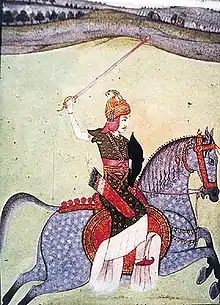
In 1723, Baji Rao organised an expedition to southern Malwa. Maratha chiefs, including Ranoji Shinde, Malhar Rao Holkar, Udaji Rao Pawar, Tukoji Rao Pawar and Jivaji Rao Pawar, had collected chauth from several parts of the province. (Later, these chiefs carved out their own kingdoms: Gwalior, Indore, Dhar and Dewas State - Junior and Senior, respectively). To counter Maratha influence, the Mughal emperor had appointed Girdhar Bahadur governor of Malwa.[1]
After defeating the Nizam, Baji Rao again turned his attention to Malwa. He consigned a large army in October 1728 to his younger brother, Chimaji Appa, and aided by his trusted generals Udaji Pawar and Malhar Rao Holkar. The Maratha force reached the southern bank of the Narmada River on 24 November 1728. The following day, they crossed the river and encamped near Dharampuri. Marching rapidly northwards, they crossed the ghat near Mandu and halted at Nalchha on 27 November. The Mughal forces, led by Girdhar Bahadur and his cousin Daya Bahadur, hastily prepared to oppose them on hearing that the Maratha army had begun to climb the ghats. Girdhar Bahadur believed that the Marathas, thinking that the pass near the Mandu fort was well guarded, would climb the ghat near Amjhera; he and his army marched to Amjhera and took up a strong position there. Since the Marathas did not appear there, he suspected that they climbed near the Mandu fort and set out for Dhar on 29 November 1728. Girdhar Bahadur found Maratha horsemen coming towards him. In the 29 November Battle of Amjhera, Chimaji's army defeated the Mughals; Girdhar Bahadur and Daya Bahadur were killed. The Mughal forces fled, and their camp was plundered; eighteen elephants, horses, drums and other loot were taken by the Marathas. News of the victory reached the ears of Peshwa, who was visiting Chhatrasal.[28] Chimaji marched towards Ujjain, but had to retreat due to lack of supplies.[1] By February 1729, Maratha forces had reached present-day Rajasthan.[22]
Bundelkhand
In Bundelkhand, Chhatrasal rebelled against the Mughal Empire and established an independent kingdom. In December 1728, a Mughal force led by Muhammad Khan Bangash attacked him and besieged his fort and family. Although Chhatrasal repeatedly sought Baji Rao's assistance, he was busy in Malwa at the time. He compared his dire situation to that of Gajendra Moksha. In his letter to Baji Rao, Chhatrasal wrote the following words:
Know you, that I am in the same sad plight in which the famous elephant was when caught by the crocodile. My valiant race is on point of extinction. Come and save my honour, O Baji Rao.[29]
In March 1729, the Peshwa responded to Chhatrasal's request and marched towards Bundelkhand with 25,000 horsemen and his lieutenants Pilaji Jadhav, Tukoji Pawar, Naro Shankar, and Davalji Somwanshi. Chhatrasal escaped capture and joined the Maratha force, increasing it to 70,000 men.[30] After marching to Jaitpur, Baji Rao's forces surrounded Bangash and cut his supply and communication lines. Bangash launched a counterattack against Baji Rao, but could not pierce his defences. Qaim Khan, son of Muhammad Khan Bangash, learned of his father's predicament and approached with fresh troops. His army was attacked by Baji Rao's forces, and he was defeated. Bangash was later forced to leave, signing an agreement that "he [would] never attack Bundelkhand again".[30] Chhatrasal's position as ruler of Bundelkhand was restored. He granted a large jagir to Baji Rao, and gave him his daughter Mastani. Before Chhatrasal's death in December 1731, he ceded one-third of his territories to the Marathas.[1]
Gujarat
After consolidating Maratha influence in central India, Baji Rao decided to assert the Maratha right to collect taxes from the wealthy province of Gujarat and sent a Maratha force under Chimaji Appa there in 1730. Sarbuland Khan, the province's Mughal governor, ceded the right to collect chauth to the Marathas. He was soon replaced by Abhay Singh, who also recognized the Maratha right to collect taxes. This irked Shahu's senapati (commander-in-chief), Trimbak Rao Dabhade, whose ancestors had raided Gujarat several times and asserted their right to collect taxes from the province. Annoyed at Baji Rao's control of what he considered his family's sphere of influence, he rebelled against the Peshwa.[31] Two other Maratha nobles from Gujarat, Damaji Rao Gaekwad and Kadam Bande, also sided with Dabhade.[22]
After Girdhar Bahadur's defeat in 1728, the Mughal emperor had appointed Jai Singh II to subdue the Marathas. Jai Singh recommended a peaceful agreement; the emperor disagreed, replacing him with Muhammad Khan Bangash. Bangash formed an alliance with the Nizam, Trimbak Rao and Sambhaji II. Baji Rao learned that Dabhade and Gaikwad had made preparations for an open fight on the plain of Dabhoi with a force of 40 thousand, while Baji Rao's numbers hardly reached 25 thousand in all. Baji Rao repeatedly sent messages to Dabhade to solve the dispute amicably in the presence of Chatrapati Shahu. But Dabhade was stiff and stubborn, disagreeing Baji Rao's proposition, therefore on 1 April 1731, Baji Rao struck at the allied forces of Dabhade, Gaekwad and Kadam Bande. The Dabhade was seated on elephant and Baji Rao was on horseback. But during the battle, a bullet pierced Trimbakrao's head and he died on the spot. Later it was discovered that the shot that killed Dabhade was fired by Dabhade's maternal uncle Bhau Singh Thoke.[32][33] Baji Rao resolved the dispute with Sambhaji II on 13 April by signing the Treaty of Warna, which demarcated the territories of Shahu and Sambhaji II. The Nizam met Baji Rao at Rohe-Rameshwar on 27 December 1732, and promised not to interfere with Maratha expeditions.[1]
Shahu and Baji Rao avoided a rivalry with the powerful Dabhade clan after subduing Trimbak Rao; Trimbak's son, Yashwant Rao, was appointed as Shahu's senapati. The Dabhade clan were allowed to continue collecting chauth from Gujarat if they deposited half the revenue in Shahu's treasury.[1]
Siddis
The Siddis of Janjira controlled a small, strategically-important territory on India's west coast. Although they originally held only the Janjira fort, after Shivaji's death they expanded their rule to a large part of central and northern Konkan.[22] After the death of Siddi chief Yakut Khan in 1733, a war of succession broke out among his sons; one, Abdul Rehman, asked Baji Rao for help. Baji Rao sent a Maratha force led by Sekhoji Angre, son of Kanhoji Angre. The Marathas regained control of several portions of Konkan, and besieged Janjira. Their strength was diverted after Peshwa's rival, Pant Pratinidhi, occupied Raigad Fort (near Janjira) in June 1733. Sekhoji Angre died in August (further weakening the Maratha position), and Baji Rao signed a peace treaty with the Siddis. He allowed the Siddis to retain control of Janjira if they accepted Abdul Rehman as the ruler; they were also allowed to retain control of Anjanvel, Gowalkot and Underi. The Marathas retained Raigad, Rewas, Thal and Chaul.[1]
The Siddis launched an offensive to regain their lost territories soon after the Peshwa returned to Satara, and Baji Rao dispatched a force to prevent them from taking over Raigad Fort in June 1734. Chimnaji made a surprise attack on a Siddi camp near Rewas on 19 April 1736, killing about 1,500 (including their leader, Siddi Sat). On 25 September of that year, the Siddis signed a peace treaty which confined them to Janjira, Gowalkot and Anjanvel.[1]
Rajputana
With Shahu's consent, Baji Rao began a northward journey on 9 October 1735. Accompanied by his wife, Kashibai,[34][35] he intended to visit Rajput courts and persuade them to pay chauth. Baji Rao arrived at Mewar's southern frontier in January 1736, where Rana Jagat Singh had made arrangements for his visit.[36][37]
Diplomatic talks got underway. Baji Rao also visited Jagmandir Palace, in the centre of Pichola Lake (at Rana Jagat Singh's invitation), and Nath-Dwara. After resolving matters in Mewar, Baji Rao advanced towards Jaipur. Jai Singh hastened south with his forces, and they met in Bhambholao (near Kishangarh).[36]
Their meeting lasted for several days, with talks about chauth and the cession of Malwa from the emperor. Baji Rao then returned to the Deccan. The emperor did not agree to his demands, however, and he planned to march on Delhi to force him to agree.[38][39]
March to Delhi
After the death of Trimbak Rao, Bangash's alliance against the Marathas fell apart. The Mughal emperor recalled him from Malwa, and re-appointed Jai Singh II as governor of Malwa. However, the Maratha chief Holkar defeated Jai Singh in the 1733 Battle of Mandsaur. After two more battles, the Mughals decided to offer the Marathas the right to collect the equivalent of ₹22 lakh in chauth from Malwa. On 4 March 1736, Baji Rao and Jai Singh reached an agreement at Kishangad. Jai Singh convinced the emperor to agree to the plan, and Baji Rao was appointed deputy governor of the region. Jai Singh is believed to have secretly informed Baji Rao that it was a good time to subdue the weakening Mughal emperor.[1]
The Peshwa began to march on the Mughal capital, Delhi, from Pune on 12 November 1736 with a force of 50,000 cavalry troops.[40] Learning of the advancing Maratha army, the Mughal emperor asked Saadat Ali Khan I to march from Agra and check the advance. The Maratha chiefs Malhar Rao Holkar, Vithoji Bule and Pilaji Jadhav crossed Yamuna and plundered the Mughal territories in the Doab. Saadat Khan led a force of 150,000, defeated them, and retired to Mathura. Malhar Rao Holkar rejoined Baji Rao's army near Gwalior. Samsam-ud-Daulah, Mir Bakshi and Muhammad Khan Bangash invited Saadat Ali Khan to a banquet in Samsam-ud-Daulah's tent in Mathura, thinking that the Marathas had retreated to the Deccan. During the feast, they learnt that Baji Rao had slipped along the Jat and Mewati hill route (avoiding the direct Agra-Delhi route) and was at Delhi. The Mughal commanders left the feast and began a hasty return to capital.[41] The Mughal emperor dispatched a force, led by Mir Hasan Khan Koka, to check Baji Rao's advance. The Marathas defeated his force in the 28 March 1737 Battle of Delhi. Baji Rao then retreated from the capital, concerned about the approach of a larger Mughal force from Mathura.[1]
Baji Rao's dash on Delhi was executed with such daring and audacity that neither the Mughal generals nor the Mughal intelligence could comprehend or predict his moves.[42][43]
Battle of Bhopal
Mughal emperor Muhammad Shah sought help from the Nizam after Baji Rao's march to Delhi; the Nizam set out from the Deccan, met Baji Rao's returning force at Sironj, and told the Peshwa that he was going to Delhi to repair his relationship with the Mughal emperor. The Nizam was joined by other Mughal chiefs, and a 30,000-man Mughal army (reinforced by artillery), was dispatched against Baji Rao. The Peshwa assembled an 80,000-man force. To counter aid to the Nizam from the Deccan, Baji Rao stationed a force of 10,000 (under Chimaji Appa) on the Tapti River with instructions to prevent Nasir Jung from advancing beyond Burhanpur. He and his forces crossed the Narmada in early December 1737, communicating with agents and spies posted to observe enemy moves. The Nizam sheltered in Bhopal, a fortified town with a lake at his rear, to keep his army and artillery secure.
Baji Rao besieged the Nizam, cutting off outside provisions. Because of the Nizam's artillery, the Marathas kept their distance and harassed their lines; no food could come in from outside, and the men and their animals were starving.[44][45] The Nizam, unable to hold out any longer, signed a peace agreement at Doraha on 7 January 1738.[46] Malwa was ceded to the Marathas; the Mughals agreed to pay the equivalent of ₹5,000,000 in reparations, with the Nizam swearing on the Quran to abide by the treaty.[1]
The Portuguese
The Portuguese had colonised several regions of India's west coast. They violated an agreement to give the Marathas a site on Salsette Island for a factory, and were intolerant of Hindus in their territory. In March 1737, the Peshwa dispatched a Maratha force (led by Chimaji) against them. Although the Marathas captured Ghodbunder Fort and nearly all of Vasai in the Battle of Vasai and gained control of Salsette on 16 May 1739 after a long siege, Nader Shah's invasion of India then diverted their attention from the Portuguese.[1] The war trophies from Vasai included several Church bells which are found in many prominent Hindu temples in Maharashtra.[47]
Battle tactics and character
Baji Rao was known for rapid tactical movements in battle, using cavalry inherited from Maratha generals such as Santaji Ghorpade and Dhanaji Jadhav.[48] Two examples are the Battle of Palkhed in 1728, when he outmaneuvered the Mughal governor of the Deccan, and in the battle against Mughal emperor Muhammad Shah at Delhi in 1737. His skill was in moving large numbers of cavalry at a great speed.[49] British field marshal Bernard Montgomery studied Baji Rao's tactics in the Palkhed campaign, particularly his rapid movements and his troops' ability to live off the land (with little concern about supply and communication lines) while conducting "maneuver warfare" against the enemy. In his book, A Concise History of Warfare, Montgomery wrote the following about Baji Rao's victory at Palkhed:
They (Marathas) were at their best in the eighteenth century, and the Palkhed campaign of 1727-28 in which Baji Rao I outgeneralled Nizam-ul-Mulk, is a masterpiece of strategic mobility. Baji Rao's army was a purely mounted force, armed only with sabre, lance, a bow in some units and a round shield. There was a spare horse for every two men. The Marathas moved unencumbered by artillery, baggage, or even handguns and defensive armour. They supplied themselves by looting.[50]
Montgomery also wrote,
Baji Rao resented the Nizam's rule over the Deccan and it was he who struck the first blow. In October 1727, as soon as rainy season ended, Baji Rao burst into the territories of Nizam. The lightly equipped Marathas moved with great rapidity, avoiding the main towns and fortresses, living off the country, burning and plundering. They met one reverse at the hands of Nizam's able lieutenant, Iwaz Khan, at the beginning of November 1727, but within a month they had fully recovered and were off again, dashing east, north, west, with sudden changes in direction. The Nizam had mobilised his forces, and for a time pursued them, but he was bewildered by the swift unpredictable movements of Marathas, and his men became exhausted.[50]
Jadunath Sarkar called Baji Rao, "a heavenly-born cavalry leader".[49] Baji Rao used local terrain to cut enemy supply lines. Leading from the front, he used the traditional Maratha tactics of encircling the enemy quickly, appearing from the rear, attacking from an unexpected direction, distracting the enemy's attention, keeping them off-balance, and defining the battlefield on his own terms. Baji Rao kept detailed information about enemy forces to himself, attacking where least expected and thus inspiring fear.[49]
Baji Rao is considered as the most charismatic and dynamic leader in the Maratha history after Shivaji.[14] He is also considered to be one of the greatest military generals of his time.[51] In his introduction to Baji Rao I: The Great Peshwa, K. M. Panikkar wrote:
Baji Rao, the great Peshwa, was without doubt the most outstanding statesman and general India produced in [the] 18th century. If Shivaji was the founder of Maratha State, Baji Rao could claim that he was the one who saved it from disruption and transformed what was national state in[to] an Empire.[52]
Chatrapati Shahu also had an implicit faith on Baji Rao. He had issued orders that, "all should obey Baji Rao faithfully and should do nothing to offend his temper".[53] On the other occasion he has called Baji Rao as "the man with iron nerves".[54]
Personal life
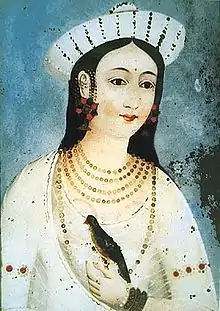
Baji Rao's first wife was Kashibai, the daughter of Mahadji Krishna Joshi and Shiubai of Chas (a wealthy banking family).[55] Baji Rao always treated his wife Kashibai with love and respect.[56] Their relationship was a happy one.[57][56] They had three sons Balaji Baji Rao (also called Nanasaheb), Raghunath Rao (also called Ragoba) and Janardhan Rao, who died at an early age.[58] Nanasaheb was appointed Peshwa by Shahu in 1740, succeeding his father.[59]
Baji Rao took a second wife, Mastani, the daughter of Rajput king Chhatrasal of Bundelkhand and his Muslim concubine.[60] The marriage was political one, arranged to please Chhatrasal.[5] Mastani had a son, Krishna Rao, in 1734. Since his mother was Muslim, the Hindu priests refused to conduct upanayana ceremony and he became known as Shamsher Bahadur.[1] After the deaths of Baji Rao and Mastani in 1740, Kashibai raised six-year-old Shamsher Bahadur as her own. Shamsher received a portion of his father's dominion of Banda and Kalpi. In 1761, he and his army fought alongside the Peshwa in the Third Battle of Panipat between the Marathas and the Afghans. Wounded in the battle, Shamsher died several days later in Deeg.[61][62][63]
Baji Rao moved his base of operations from Saswad to Pune in 1728, laying the foundation for the transformation of a kasba into a large city.[64] He began the construction of Shaniwar Wada in 1730. It was completed in 1732, beginning the era of Peshwa control of the city.[65]
Death
Baji Rao caught with a virulent fever when he was encamped in Raverkhedi and died on 28 April 1740.[66] He was cremated that day on the Narmada River. His body was exhausted due to ceaseless wars and military campaigns.[67] Balaji Baji Rao ordered Ranoji Shinde to built a chhatri as a memorial. The memorial is enclosed by a dharmashala. The compound has two temples, dedicated to Nilkantheshwara Mahadeva (Shiva) and Rameshvara (Rama).[68]
In popular culture
Rau, a 1972 fictional Marathi novel by Nagnath S. Inamdar, featured a love story of Baji Rao I and Mastani.[69]
The 2015 historical drama film Bajirao Mastani, directed by Sanjay Leela Bhansali, starred Ranveer Singh as Baji Rao I.[70]
Peshwa Bajirao, a 2017 TV series starring Rudra Soni as young Baji Rao and Karan Suchak as the adult Baji Rao, aired on Sony TV.[71]
See also
References
- Chhabra, G. S. (2005) [1971]. Advanced Study in the History of Modern India (Volume 1: 1707–1813) (Revised ed.). Lotus Press. p. 19. ISBN 978-81-89093-06-8.
- Gokhale, Sandhya (2008). The Chitpavans: social ascendancy of a creative minority in Maharashtra, 1818–1918. Shubhi. p. 82. ISBN 978-81-8290-132-2.
- Athale, Anil A. "Why Bajirao is India's greatest cavalry general". rediff.com.
- "Celebrating Bajirao, the legendary warrior in Indian history who never lost a battle in his life". Retrieved 15 July 2020.
- Mehta, Jaswant Lal (2005). Advanced Study in the History of Modern India: 1707 – 1813. New Delhi: New Dawn Press. p. 97,215. ISBN 9781932705546.
The reputation of the young Peshwa as a brilliant military general soared very high...","They objected to the marriage of Baji Rao with Mastani...
- "Peshwa Bajirao Review: Anuja Sathe shines as Radhabai in the period drama", India Today, 25 January 2017
- Jha, Subhash K (19 October 2015). "Bajirao Mastani review: This gloriously epic Priyanka, Deepika and Ranveer-starrer is the best film of 2015". Firstpost. Retrieved 19 October 2015.
- Inamdar, N. S. (20 October 2016). Rau – The Great Love Story of Bajirao Mastani. Pan Macmillan. ISBN 978-1-5098-5227-7.
- Barave, Dinakara Dattātraya; Barve (Barave) Kula Snehasãvardhaka Maṇḍaḷa (2007). Barave (Barve) gharāṇyācā kulavr̥ttānta. p. 471. OCLC 824536402.
- Sardesai, Govind Sakharam (1946). New History of the Marathas: The expansion of the Maratha power, 1707-1772. Phoenix Publications. p. 60.
- Sardesai, Govind Sakharam (1946). New History of the Marathas: The expansion of the Maratha power, 1707-1772. Phoenix Publications. p. 67.
- Dighe, Vishvanath Govind (1944). Peshwa Bajirao I and Maratha Expansion. Karnatak Publishing House. p. 4.
- Sardesai, Govind Sakharam (1946). New History of the Marathas: The expansion of the Maratha power, 1707-1772. Phoenix Publications. p. 66.
- Gordon, Stewart (1993). The New Cambridge History of India. Cambridge University Press. p. 114.
- Sharma, Shripad Rama (1951). The Making of Modern India: From A. D. 1526 to the Present Day. Orient Longmans. p. 239.
- Puri, B. N.; Das, M. N. (2003). A Comprehensive History of India: Comprehensive history of medieval India. Sterling. p. 212. ISBN 978-81-207-2508-9.
- Mehta, Jaswant Lal (2005). Advanced Study in the History of Modern India: 1707 – 1813. New Delhi: New Dawn Press. pp. 492–494. ISBN 9781932705546.
- Chhabra, G. S. (2005) [1971]. Advanced Study in the History of Modern India (Volume 1: 1707–1813) (Revised ed.). Lotus Press. p. 20. ISBN 978-81-89093-06-8.
- Sen, S. N. (2006). History Modern India. New Age International. p. 11. ISBN 978-81-224-1774-6.
- Gordon, Stewart (2007). The Marathas 1600–1818. Cambridge [u.a.]: Cambridge University Press. pp. 117–121. ISBN 978-0521033169.
- Sardesai, Govind Sakharam (1946). New History of the Marathas: The expansion of the Maratha power, 1707-1772. Phoenix Publications. pp. 65, 69.
- Gordon, Stewart (2007). The Marathas 1600–1818. Cambridge [u.a.]: Cambridge University Press. pp. 120–131. ISBN 978-0521033169.
- Kate, P. V. (1987). Marathwada Under the Nizams, 1724–1948. Mittal. pp. 11–13. ISBN 978-81-7099-017-8.
- Dighe, Vishvanath Govind (1944). Peshwa Bajirao I and Maratha Expansion. Karnatak Publishing House. p. 18.
- Sardesai, Govind Sakharam (1946). New History of the Marathas: The expansion of the Maratha power, 1707-1772. Phoenix Publications. pp. 96–97.
- Sardesai, Govind Sakharam (1946). New History of the Marathas: The expansion of the Maratha power, 1707-1772. Phoenix Publications. p. 98.
- Sarkar, Jadunath (1960). Military History of India. M. C. Sarkar and Sons. p. 143.
- Sinh, Raghubir (1936). Malwa in Transition The First Phase 1698-1765. D.B Taraporevala, Sons & Co. pp. 162, 163, 164.
- Sardesai, Govind Sakharam (1946). New History of the Marathas: The expansion of the Maratha power, 1707-1772. Phoenix Publications. p. 106.
- Sardesai, Govind Sakharam (1946). New History of the Marathas: The expansion of the Maratha power, 1707-1772. Phoenix Publications. pp. 106–108.
- Chhabra, G. S. (2005) [1971]. Advanced Study in the History of Modern India (Volume 1: 1707–1813) (Revised ed.). Lotus Press. p. 22. ISBN 978-81-89093-06-8.
- Dighe, Vishvanath Govind (1944). Peshwa Bajirao I and Maratha Expansion. Karnatak Publishing House. p. 38,39.
- Sardesai, Govind Sakharam (1946). New History of the Marathas: The expansion of the Maratha power, 1707-1772. Phoenix Publications. p. 128.
- Sarkar, Jadunath (1964). Fall Of The Mughal Empire. 1. Longman Group. p. 161.
- Sardesai, Govind Sakharam (1946). New History of the Marathas: The expansion of the Maratha power, 1707-1772. Phoenix Publications. p. 151.
- Sarkar, Jadunath (1964). Fall Of The Mughal Empire. 1. Longman Group. p. 162.
- Sardesai, Govind Sakharam (1946). New History of the Marathas: The expansion of the Maratha power, 1707-1772. Phoenix Publications. p. 150.
- Sarkar, Jadunath (1964). Fall Of The Mughal Empire. 1. Longman Group. pp. 163–164, 168.
- Sardesai, Govind Sakharam (1946). New History of the Marathas: The expansion of the Maratha power, 1707-1772. Phoenix Publications. pp. 151–152.
- Dighe, Vishvanath Govind (1944). Peshwa Bajirao I and Maratha Expansion. Karnatak Publishing House. p. 130.
- Irvine, William. Later Mughals. 2. Oriental Books Reprint Corporation. p. 288.
- Srinivasan, C. K. (1961). Baji Rao I: The Great Peshwa. New Delhi: Asia Publishing House. p. 105.
- Dighe, Vishvanath Govind (1944). Peshwa Bajirao I and Maratha Expansion. Karnatak Publishing House. p. 134.
- Dighe, Vishvanath Govind (1944). Peshwa Bajirao I and Maratha Expansion. Karnatak Publishing House. pp. 146, 148.
- Sardesai, Govind Sakharam (1946). New History of the Marathas: The expansion of the Maratha power, 1707-1772. Phoenix Publications. pp. 157–158.
- Bakshi, S. R.; Ralhan, O. P. (2007). Madhya Pradesh Through the Ages. Sarup & Sons. p. 384. ISBN 978-81-7625-806-7.
- Lopez, Rachel (2018). "Why bells from Portuguese-era churches ring in temples across Maharashtra". Hindustan Times (Dec 24, 2018). HT Media Limited. Retrieved 23 December 2020.
- Kantak, M.R. (1993). The First Anglo-Maratha War, 1774-1783: A Military Study of Major Battles. Popular Prakashan Pvt Ltd. p. 12. ISBN 9788171546961.
- Dighe, Vishvanath Govind (1944). Peshwa Bajirao I and Maratha Expansion. Karnatak Publishing House. p. 206.
- Montgomery, Bernard (1972). A Concise History of Warfare. Collins. pp. 132, 135.
- Mehta, Jaswant Lal (2005). Advanced Study in the History of Modern India: 1707 – 1813. New Delhi: New Dawn Press. p. 126. ISBN 9781932705546.
- Srinivasan, C. K. (1961). Baji Rao I: The Great Peshwa. New Delhi: Asia Publishing House. p. ix.
- Sardesai, Govind Sakharam (1946). New History of the Marathas: The expansion of the Maratha power, 1707-1772. Phoenix Publications. p. 168.
- Dighe, Vishvanath Govind (1944). Peshwa Bajirao I and Maratha Expansion. Karnatak Publishing House. p. 196.
- Gokhale, Sandhya (2008). The Chitpavans: social ascendancy of a creative minority in Maharashtra, 1818–1918. Sandhya Gokhale. p. 82. ISBN 9788182901322.
- Mishra, Garima (3 January 2016). "Tracing Kashibai: The 'first' lady from Bhansali's Bajirao Mastani". The Indian Express. Retrieved 30 July 2017.
- Mehta, Jaswant Lal (2005). Advanced Study in the History of Modern India: 1707 – 1813. New Delhi: New Dawn Press. p. 124. ISBN 9781932705546.
- Saha, B. P. (1997). Begams, concubines, and memsahibs. Vikas. p. 88. ISBN 9788125902850.
- Sardesai, Govind Sakharam (1946). New History of the Marathas: The expansion of the Maratha power, 1707-1772. Phoenix Publications. p. 189.
- Jaswant Lal Mehta (1 January 2005). Advanced Study in the History of Modern India 1707-1813. Sterling Publishers Pvt. Ltd. p. 108. ISBN 978-1-932705-54-6.
Of his own sweet will The Rajput king bestowed a large number of Personal Jagir to Bajirao near Jhansi and further offer hand of her daughter Mastani born from his Muslim Concubine
- Dodwell, Henry (1937). The Cambridge History of India: Turks and Afghans. CUP Archive. p. 407. GGKEY:96PECZLGTT6.
- Srinivasachari, Chidambaram S. (1951). The Inwardness of British Annexations in India. University of Madras. p. 219.
- Crill, Rosemary; Jariwala, Kapil (2010). The Indian Portrait, 1560–1860. Mapin Publishing Pvt Ltd. p. 162. ISBN 978-81-89995-37-9.
- Kosambi, Meera (1989). "Glory of Peshwa Pune". Economic and Political Weekly. 24 (5): 247.
- Parasnis, D. B. (1921). Poona In Bygone Days. Bombay The Times Press. pp. 1–2.
- Dighe, Vishvanath Govind (1944). Peshwa Bajirao I and Maratha Expansion. Karnatak Publishing House. p. 203.
- Srinivasan, C. K. (1961). Baji Rao I: The Great Peshwa. New Delhi: Asia Publishing House. p. 128.
- "Brindaban dedicated to the memory of Shrimant Baji Rao Peshwa". ASI Bhopal. Retrieved 23 December 2015.
- Inamdar, N. S. (20 October 2016). Rau – The Great Love Story of Bajirao Mastani. Pan Macmillan. ISBN 978-1-5098-5227-7.
- Jha, Subhash K (19 October 2015). "Bajirao Mastani review: This gloriously epic Priyanka, Deepika and Ranveer-starrer is the best film of 2015". Firstpost. Retrieved 19 October 2015.
- "Peshwa Bajirao Review: Anuja Sathe shines as Radhabai in the period drama", India Today, 25 January 2017
Further reading
- Palsokar, R. D.; Reddy, T. Rabi (1995). Bajirao I: An Outstanding Cavalry General. Reliance Publishing House. ISBN 978-81-85972-94-7.
- Paul, E. Jaiwant (2000). Baji Rao: The Warrior Peshwa. Roli Books. ISBN 978-81-7436-129-5.
- Kulkarni, Uday S (2016). The Era of Baji rao. Mula-Mutha Publishers. ISBN 978-81-9210-803-2.
- Godse, D. G. (1989). मस्तानी [Mastani] (in Marathi). Popular Prakashan Pvt. Limited. ISBN 978-81-7185-363-2.
External links
| Wikimedia Commons has media related to Baji Rao I. |
| Preceded by Balaji Vishwanath Bhat |
Peshwa 1720–1740 |
Succeeded by Balaji Baji Rao |

